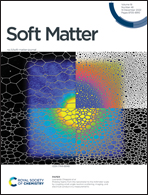Photoswitches with different numbers of azo chromophores for molecular solar thermal storage†
Abstract
We investigate three azo-chromophore-containing photoswitches (1, 2 and 3) for molecular solar thermal storage (MOST) based on reversible Z–E isomerization. 1, 2 and 3 are photoswitchable compounds that contain one, two and three azo chromophores, respectively. In solution, 1, 2 and 3 were charged via UV-light-induced E-to-Z isomerization. Among these three compounds, 2 exhibited an energy density as high as 272 ± 1.8 J g−1, which showed the best energy storage performance. This result originated from the low molecular weight, a high degree of photoisomerization, and moderate steric hindrance of 2, which demonstrated the advantages of the meta-bisazobenzene structure for MOST. In addition, we studied the performances of these photoswitches in the solvent-free state. Only 1 showed photoinduced reversible solid-to-liquid transitions, which enabled the charging of 1 in a solvent-free state. The stored energy density for 1 in a solvent-free state was 237 ± 1.5 J g−1. By contrast, 2 and 3 could not be charged in the solvent-free state due to the lack of solid-state photoisomerization. Our findings provide a better understanding of the structure–performance relationship for azobenzenebased MOST and pave the way for the development of high-density solar thermal fuels.



 Please wait while we load your content...
Please wait while we load your content...